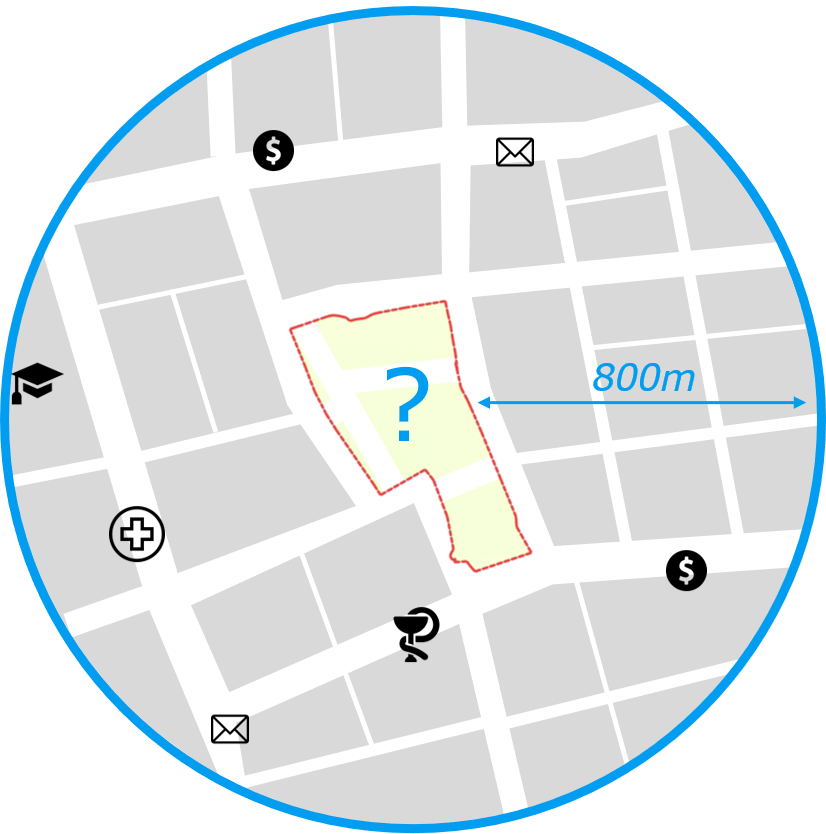How to deliver a 20-minute neighbourhood
There is a growing ambition for walking neighbourhoods and improved local areas from city authorities all over the world. From superblock models in Barcelona to low traffic neighbourhoods in London to Scotland’s 20-minute neighbourhoods or 15-minutes cities in Paris, everywhere has its own interpretation or idea of how to implement this principle. The unified aim of which is to reduce private vehicle travel and ensure fair and equal access to daily needs all in a bid to improve the health and wellbeing of communities and even make an impact on climate change. In parallel to this, there is the need to deliver new homes and utilise our disused land stock. With all these challenges facing our communities, how do we work out the way to actually deliver on these policies, in reality?
 To show how this challenge can be addressed, the SiteSolve team have undertaken a study to see how leveraging technology can help identify practical steps to move towards a walking neighbourhood. This case study focusses on an area in North London, where 514 sites have been identified as having potential for housing through the Strategic Housing Land Availability Assessment (SHLAA). Using SiteSolve and GIS mapping data the study aims to identify the actions which will have both the quickest and the largest return on investment for the community, to help identify the short- and long-term focus areas. Have a look at the following sections to find out how!
To show how this challenge can be addressed, the SiteSolve team have undertaken a study to see how leveraging technology can help identify practical steps to move towards a walking neighbourhood. This case study focusses on an area in North London, where 514 sites have been identified as having potential for housing through the Strategic Housing Land Availability Assessment (SHLAA). Using SiteSolve and GIS mapping data the study aims to identify the actions which will have both the quickest and the largest return on investment for the community, to help identify the short- and long-term focus areas. Have a look at the following sections to find out how!
How many of the SHLAA sites have access to amenities of a walking neighbourhood?
Using open-source data, the study could identify which sites had access to five priority amenities for a walking neighbourhood: banks, medical facilities, educational institutes, pharmacies, and post offices. This data can be used to identify the quick win sites which would achieve ambitions of providing much needed housing in a walking neighbourhood. Other considerations, such as accessibility to quality green space, local transport hubs or fresh food, could also be included in future studies to build an even more holistic picture of your local area.
What percentage of the sites were cost viable for new housing, now? How many housing units could be unlocked?
SiteSolve was able to test thousands of massing iterations, with every option generated meeting key architectural and engineering rulesets, selecting the best option to maximise financial viability of the site. It enabled an understanding of the true development potential of the site and helped to identify tipping points where building less units actually resulted in a better return. This is one of the key findings we have identified in previous studies, such as our Mass Land Viability Study undertaken for Transport for London, where there was a detailed cost methodology around site abnormalities.
Where could investment of a specific amenity be prioritised to maximise benefit to communities?
In parallel the data can be evaluated to see which areas could benefit from greater investment in local amenities. The interactive dashboard allows for this data to be digested visually, and clusters to be identified where an additional amenity may benefit a greater number of sites/number of new homes.
 Clusters of sites with no education access within their walking neighbourhood
Clusters of sites with no education access within their walking neighbourhood
How does this change in 3 years time?
One of the key benefits of using generative technology for this study, such as SiteSolve, is that it enables multiple case studies or scenarios to be rapidly run to understand the impact that different assumptions or time may have. The results of this study will show the difference between two case studies, one for cost and value data based on current day alongside a future case in 3 years time. This could also consider the impact of different policy or investment strategies on the homes and walking neighbourhoods that could ultimately be created, or even run sensitivity analysis to understand the main risks and opportunities involved.
The results of this work will show you the kinds of outputs and information you can draw from undertaking a study like this. The study was undertaken using open source data and our internal methodology, however this process can easily be adapted to your local requirements and ambitions. This can help you to deliver on your policy by helping to drive your decision making on where has the most potential or where more investment is required.
You will have to wait to see the results of the full study which will be available in the coming weeks. Sign up to our newsletter to be the first to know the results of this pioneering walking neighbourhood study.
